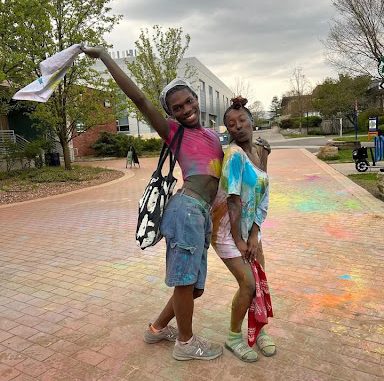
Starting on April 21, SUNY New Paltz’s Caribbean Student Association (CSA) put on a week’s worth of events inspired by Caribbean traditions. The association specifically curated engaging, informational and welcoming opportunities for attendees to participate in.
The events were planned for several months, with CSA renting spaces, seeking approval and creating flyers to promote through social media and on campus.
On their Engage site, CSA is described as “a student-led club that celebrates culture and heritage while educating and bringing awareness about West Indian Caribbean culture and the African Diaspora on the SUNY New Paltz campus.”
Fourth-year adolescent education major Jayden Mahadeo is president of CSA. Initially, Mahadeo joined as a choreographer, then held the position of vice president before rising to the title of president. “I will say it has been a huge adjustment for me. I’ve led other clubs before, but I never led something cultural-wise,” Mahadeo said. Third-year psychology major Jazmine Alvarez-Webster is the co-president of the association.
The club has not always been an association. CSA has been active on New Paltz’s campus for more than two decades but has undergone some updates in its name — officially adopting the title of Caribbean Student Association in 2021. Mahadeo said, “There was a negative view on CSA, and so this year Alvarez-Webster and I had been trying to flip the whole image of what [CSA] is about. That’s been our goal, and it’s been working so far.”
Prior to 2021, CSA was the Caribbean Student Organization. The significance of this change in terminology weighs heavily on the group’s leaders. Mahadeo described the intensity and stigma surrounding the phrase “organization.” He said, “When you think of an organization you think, ‘I have to do some type of initiation.’” He explained how the shift from organization to association can benefit those interested in joining. “I mean, think of association. You think, ‘okay, this is something that’s for me. It’s all people.’ Everyone is welcomed into this, and this is what the goal was — to make everyone so welcome,” Mahadeo said.
April 21 was the CSA’s Caribbean Card Revoked game night. This is played around the world in celebration of Caribbean Week. Two groups go head-to-head trying to get as many questions correctly with only 10 seconds to answer.
On the evening of April 22, the association hosted a game of “guess that tune” in the Humanities building room 214. Caribbean songs were played and attendees had to figure out which song was being played.
On April 23, CSA hosted “After Dark: Confessions” as a continuation of Caribbean Week.
April 24 was CSA’s paint and sip night at 7 p.m. in Coykendall Science Building room 001. Attendees got the opportunity to mingle with their friends and sip on beverages while painting.
“Usually, we throw our Caribbean week during rainbow month, which is technically right now, but we usually do it in between the second and third week. Unfortunately, this year we didn’t. Overall things have been great — other than people not really being as present as we wanted them to be. The idea of it has been going really well. Saturday, we have our huge event called Carnival. I’m hoping the turnout is better than what it has been so far,” said Mahadeo.
On April 25, the association hosted a vision board making event along with the Fahari Libertad, SUNY New Paltz’s literary magazine that shares authentic narratives of people of color. The event was held in the Student Union Building room 409 at 7:30 p.m. and allowed for a space to express one’s hopes, goals and dreams.
On April 26, CSA kicked off the unofficial start to the carnival with J’ouvert — a traditional festival or “break day.”
Jour ouvert — more commonly J’ouvert — is a celebration of the vast Caribbean culture and diaspora. The origins of Carnival originated in Trinidad and Tobago in 1783. The celebration officially took to the streets following emancipation in 1838.
First-year accounting major Taina Campos has been an active member of the association for nearly two semesters. Campos commented on her experience at the event. “It was so fun, the food we had was really good and throwing the powder was the best part about the whole event. It was a great bonding moment for everyone who showed up,” said Campos.
This was the event they had been leading up to all week: the Caribbash Carnival. This celebration is representative of a Caribbean Carnival that celebrates the diversity amongst African, Indigenous and South Indian cultures. A Caribbean tradition, Carnival is typically a week-long event which is dedicated to the celebration of various Caribbean countries.
Caribbash can be described as a “huge production where we can make outfits, a setlist, create dances and do modeling. We build this whole production based on carnival, and we do a replica of it not so much of the main version,” said Mahadeo.
Mahadeo commented on how construction impacted their ability to host an event on such a large scale. “We usually have it in the Multipurpose Room, but due to it being renovated this year, we couldn’t throw our huge production. We couldn’t find space inside that could fit the amount of people that usually come,” Mahadeo said.
This year’s Carnival was held on Old Main Quad at 3 p.m., with limited amounts of free color powder, food and music throughout the evening. The event additionally showcased dance, art, music and other forms of expression. This year, approximately 35 people attended the event, according to Mahadeo.
Campos commented on her experience at J’ouvert, “I left the event full and happy. I definitely can’t wait to do it again next year.”
